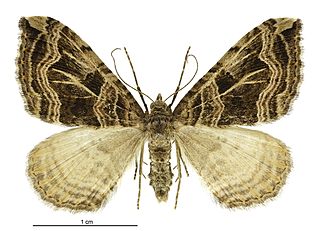
Xanthorhoe semifissata, commonly known as the barred pink looper. is a moth of the family Geometridae. It is endemic to New Zealand and is found throughout the country although it is much less common in the mountains in the south and west of the South Island. The larvae host plants include Nasturtium officinale as well as species in the Cardamine genus. Adult moths inhabit shrubs at the edge of native forest.

Helastia cinerearia is a moth of the family Geometridae. It is endemic to New Zealand and can be found in the North, South and Stewart Islands as well as on the Mercury and Chatham Islands. The preferred habitat of H. cinerearia includes urban gardens, various types of forest and sub alpine habitats. The larval host is lichen on rocks. The adult moths are on the wing all year round but are most commonly observed from September until February. Adult moths are nocturnal and have been observed feeding from and likely pollinating Hebe salicifolia, Hoheria lyallii and Leptospermum scoparium.

Asaphodes adonis is a species of moth in the family Geometridae. It is endemic to the South Island of New Zealand. It is found in native forest at altitudes of between 300 and 1200 metres. Larvae have been reared on species of Ranunculus. Adults are on the wing in January and February.

Asaphodes albalineata is a species of moth in the family Geometridae. It is endemic to New Zealand and has been observed on Stewart Island / Rakiura. This species is similar in appearance to Asaphodes oraria but can be distinguished as it has an unusual pattern on the underside of its hindwings. It inhabits open hill tops and adults are on the wing in December.
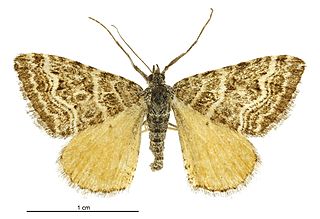
Xanthorhoe bulbulata is a species of moth in the family Geometridae. It is endemic to New Zealand. It is classified as critically endangered by the Department of Conservation.

Asaphodes chlamydota is a moth in the family Geometridae. It is endemic to New Zealand, and can be found in the lower part of the North Island and in the South Island. It inhabits native forest and shrublands. The larvae of this species feeds on native Clematis plants including Clematis afoliata. Adults are on the wing from November to April and are regarded as having intermedia flight powers.

Asaphodes chlorocapna is a species of moth in the family Geometridae. This species is endemic to New Zealand and can only be found in the Chatham Islands. The larvae of this species consume the leaves of Muehlenbeckia plants. Adults are on the wing in January. This species is classified as "At Risk, Relict'" by the Department of Conservation.

Helastia clandestina is a moth of the family Geometridae. This species is endemic to New Zealand and is found only in the South Island in and around Arthur's Pass. Adults have been collected on the wing in February and are nocturnal. Its preferred habitat is dry stony riverbeds and flood plains. The glossy blueish grey colouration of the adults of this species helps camouflage them against the rocks in their preferred habitat. H. clandestina is classified as having the conservation status of "At Risk, Relict'" by the Department of Conservation.

Asaphodes citroena is a species of moth in the family Geometridae. This species is endemic to New Zealand and has been collected in Westland. It inhabits native forest and scrub and has also been collected in open spaces along riverbeds. Adults are on the wing in December and January.
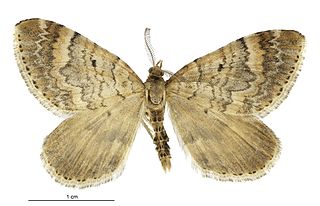
Asaphodes dionysias is a species of moth in the family Geometridae. This species is endemic to New Zealand and is only known from mountainous areas in Central Otago. It lives in open grassy mountainous habitat at altitudes up to 1750 m. It is also known to live in wetland habitat. The larvae of this species feed on native herbs. The adults of this species are on the wing in January and February. The adult female of the species has reduced wing size in comparison to the male.

Asaphodes glaciata is a species of moth in the family Geometridae. This species is endemic to New Zealand. This moth has only be found in Westland in the areas near Fox and Franz Josef Glaciers. Adults of this species are on the wing in January.
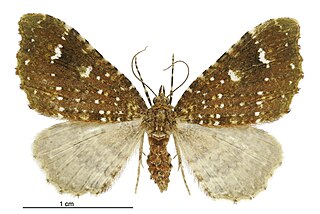
Asaphodes limonodes is a species of moth in the family Geometridae. It is endemic to New Zealand and is found in both the North and South Islands. This species inhabits damp native forest. Adults are on the wing from November until March.
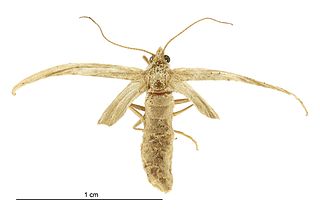
Asaphodes oraria is a species of moth in the family Geometridae. This species is endemic to New Zealand and has been observed in the southern South Island and on Stewart Island / Rakiura. The male is pale yellow coloured and the female has severely reduced wings and is flightless. The habitat of this species is tussock grasslands on coastal sand dunes and in the mountains at elevations of approximately 4,000 ft. The larvae have adapted to feeding on exotic lawn daisy species in the genus Bellis. The adults of this species are on the wing from November to April.

Asaphodes oxyptera is a species of moth in the family Geometridae. This species is endemic to New Zealand and is only found in the Auckland Islands.

Asaphodes prasinias is a moth in the family Geometridae. It is endemic to New Zealand and has been found on both the North and South Islands. This species inhabits native forest including beech forest and subalpine scrub. The range of this species has reduced as this species is regarded as being locally extinct in the previously inhabited open non-forest habitats around Invercargill. Adults are on the wing from November to January.

Asaphodes recta is a moth in the family Geometridae. It is endemic to New Zealand and is found in the southern parts of the South Island. The preferred habitat of this species is open tussock grassland. The adults are on the wing in February and March. Larvae of this species have been reared on species in the genera Ranunculus and Bellis.

Asaphodes sericodes is a moth in the family Geometridae. It is endemic to New Zealand and has been observed in the southern parts of the South Island. This species inhabits open tussock grasslands in subalpine scrub or wetlands. The female of the species is likely semi-apterous and is flightless. The adult males are on the wing in January.
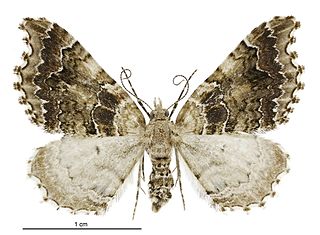
Helastia cymozeucta is a moth of the family Geometridae. It was first described by Edward Meyrick in 1913. This species is endemic to New Zealand and is found in both the North and the upper parts of the South Island. The adults of this species have been observed on the wing from November to January as well as in March.

Helastia farinata is a moth of the family Geometridae. It was first described by William Warren in 1896. This species is endemic to New Zealand and is found in the North Island. H. farinata inhabits shady and damp forest ravines.

Helastia semisignata is a moth of the family Geometridae. This species is endemic to New Zealand and is only found in the North Island. The life history of this species is in need of further investigation as sources differ about what plants host the larvae. Adults are on the wing commonly from October until March.





















